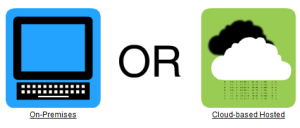We have touched upon the benefits of hosted software before, but we have yet to provide a side-by-side comparison of hosted and on-premises. The following post will serve as an overview guide to the difference between these deployment methods.
The Advantages/Disadvantages of On-Premises Software:
| Advantages |
Disadvantages |
- Data is stored inside the organization
- Increased customization and control of systems
- No monthly subscription fees
- No internet connection required
- Hardware can be shared between other internal systems
- Possibly quicker performance
- Easier to integrate with 3rd party applications and other systems
- Client-owned software
|
- Larger initial investment
- Hardware upgrades and maintenance required
- In-house IT management recommended
- Physical space required
- Software upgrades must be handled on the client end
|
The Advantages/Disadvantages of Hosted (Online) Software:
| Advantages |
Disadvantages |
- Reduced upfront cash outlay.
- Infrastructure costs pushed to provider
- No more worrying about backups.
- Painless upgrades
- Increases access to expert support (in lieu of an IT department)
- Remotely accessible
- Improved security and reliability
- Possibly increased uptime
- Immediate or quick access to a broad range of applications
|
- Reduced control of systems
- Data stored outside the organization
- Internet connection required
- Client does not own the software
|
As you can see from the tables above, each deployment method has its strengths and weaknesses. Although many vendors cling desperately to one method or the other, some vendors offer both hosted and on-premises. Depending on your personal preferences and type of business, one deployment method may be preferable than the other.










